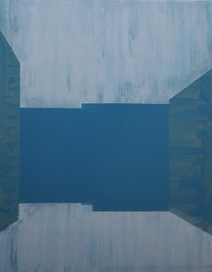Hurvin Anderson, Peter’s Series 2007 – 2009
Tate Britain
3 Feb – 19 April 09
Hurvin Anderson seems to want to both express and withhold in this series of paintings depicting, each in their way, one of the many barbershops in people’s homes where his father and other Caribbean immigrants to Britain used to go for a haircut and socializing. The first works in the series predated any of the eight paintings here, as he details in a conversation with Thelma Golden reprinted in the gallery notes. It starts with photographs he took. When, much later, he felt compelled to paint the room in the photos, he also came to feel a protectiveness towards that deeply personal space. This movement between degrees of revelation and concealment makes the exhibition very interesting as a series of paintings in which the decisions and revisions of the artist are evident and form both a sort of narrative and inner dialogue.
In the individual paintings, as well, there is movement between different layers and levels of expression. There is a choppiness to the shapes, which are almost brashly flat. One wall in all the paintings is slightly in front of the parallel one behind it, and as this corner occurs in almost the middle of the paintings it appears to create a break in the canvas, like when the original shifts on the photocopier screen and a two-dimensional crease is printed across the page.
Moving counter-clockwise from the door, “Peter’s I” sets the standard image – turquoise walls between white ceiling and ruddy floor, various mirrors or frames, a desk or table in the center against a wall, white base boards, a stool. “Peter’s II” is a simplified version of “I” – objects and details are missing; the floor is a paler red. “Peter’s III” is just walls and floor, though they could simply be 2D shapes now as the ceiling and floor are the same color so that the turquoise walls are floating in a bright sky. In “Peter’s (Pioneer) IV” the details are back, but rearranged – objects, in particular the paintings/mirrors on the walls, are painted over by the turquoise of the walls; some negative spaces are left in the turquoise where the wall hangings should be, forming a gap like when the film peels off a corner of a tinted car window. “Peter’s: Sequel” combines elements of “I” and “II”, but smoother.

Peter's III, 2007

Peter's (Pioneer) IV, 2007
A figure appears, his back to us, in “Peter’s: Back”, and the picture starts to really come into focus, as if now the pieces make sense. They have not changed, but the figure has put them into perspective, literally. “Peter’s: Sitters” does not quite fit with the other paintings. There are only two of the four walls, and with the same figure sitting in front of them, facing rear, they are not so much walls as shapes framing a portrait. Finally, in “Peter’s: Sitters II” the ceiling seems to open up and become sky, not by any act of its own but because the floor turns the same color as the walls.

Peter's: Back, 2008
The paintings are arranged chronologically, counter-clockwise, and the series can be seen as a progressive effort to convey on canvas something Anderson experienced in an entirely unaesthetic way. It is significant, then, that they are based on photos, secondary reproductions he came back to long after the fact, rather than the actual space he remembers and was a part of. The series is also, then, an ongoing dialogue with both the remembered space, with all its cultural and sociopolitical associations, and a previous piece of his own work, the photos. Before leaving, I cannot help looking up and noticing how the outward-opening angles of the paintings’ ceilings echo those of the skylights in the gallery, and how even between this airy whitewashed space and Anderson’s attic barbershop there is a subtle dialogue. – M.O. Berger
—
Further reading:
Hurvin Anderson biography: http://www.thomasdane.com/artist.php?artist_id=1
http://www.frieze.com/shows/review/hurvin_anderson/
http://www.anthonymeierfinearts.com/exhibits/anderson.htm
Leave a comment